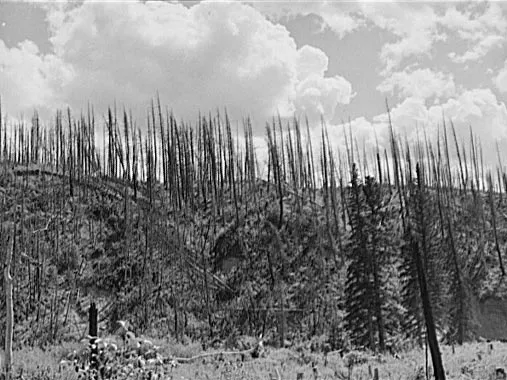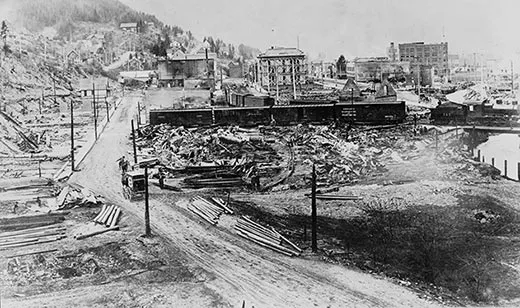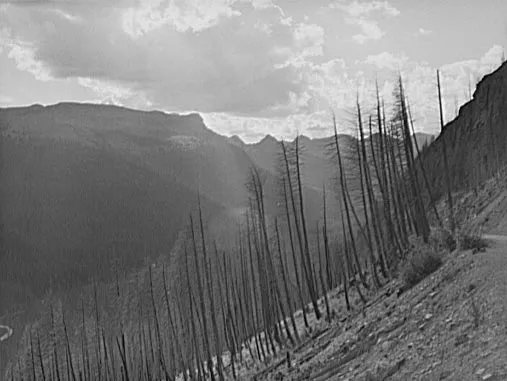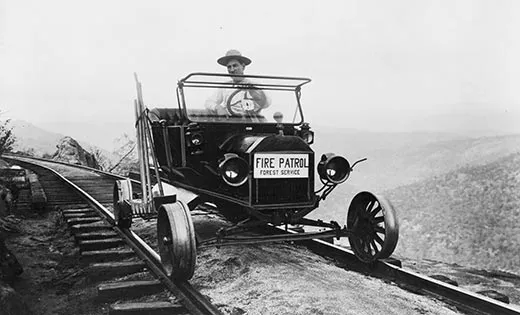The Legacy of America’s Largest Forest Fire
A 1910 wildfire that raged across three Western states helped advance the nation’s conservation efforts
/https://tf-cmsv2-smithsonianmag-media.s3.amazonaws.com/filer/town-in-Idaho-destroyed-by-1910-forest-fire-631.jpg)
Excerpted from The Big Burn: Teddy Roosevelt and the Fire that Saved America, by Timothy Egan, © 2009. Published by Houghton Mifflin Harcourt. Reproduced with permission.
Here now came the fire down from the Bitterroot Mountains and showered embers and forest shrapnel onto the town that was supposed to be protected by all those men with faraway accents and empty stomachs. For days, people had watched it from their gabled houses, from front porches and ash-covered streets, and there was some safety in the distance, some fascination even—See there, way up on the ridgeline, just candles flickering in the trees. But now it was on them, an element transformed from Out There to Here, and just as suddenly in their hair, on front lawns, snuffing out the life of a drunk on a hotel mattress, torching a veranda. The sky had been dark for some time on this Saturday in August of 1910, the town covered in a warm fog so opaque that the lights were turned on at three o’clock in the afternoon. People took stock of what to take, what to leave behind. A woman buried her sewing machine out back in a shallow grave. A pressman dug a hole for his trunk of family possessions, but before he could finish the fire caught him on the face, the arms, the neck.
How much time did they have until Wallace burned to the ground? An hour or two? Perhaps not even that? When the town had been consumed by flame twenty years earlier, it fell in a deep exhale—painted clapboards, plank sidewalks, varnished storefronts. Whoooommmppffffff! Then they did what all Western boomers did after a combustible punch: got up from the floor and rebuilt, with brick, stone and steel, shaking a fist again at nature. And since there was so much treasure being stripped from the veins of these mountains on the high divide between Montana and Idaho, they rebuilt in a style befitting their status as the source of many a bauble in the late Gilded Age. Italian marble sinks went into barbershops. Cornices were crafted of cast-iron. Terracotta trim decorated bank windows. The saloons, the bordellos, the rooming houses, the men’s clubs and hotels—fireproof, it said on their stationery. Most impressive of all was the new train depot of the Northern Pacific Railroad. It was Chateau-style, with buff-colored bricks forming a Roman arch over the main window. Three stories, counting the magnificent turret, and shingled in green. The depot was an apt hub for a region that promised to produce more silver, lead and white pine than any other on the planet.
“It seemed like a toy city,” a novice forest ranger said after he had crested the mountains by train and caught his first sight of Wallace, Idaho, “clean and spotless, and very much up to date, with fine homes and fine people.”
In early evening, the young mayor, Walter Hanson, checked with his fire chief, and he summoned his assistant, and they said, yes, it was time—Sound the alarm! That was it; everyone knew they had to make a dash for the getaway trains. Women and children only, the mayor said, with a Victorian gentleman’s reflex common even in the Far West. He deputized an instant force of local men to back him up. Troops were available as well, the “Negro soldiers” of the 25th Infantry, I Company, who had just pitched a hurried camp on the Wallace baseball field after withdrawing from the aggressive front line of the fire. Over the years, they had chased Indians in the Dakotas, put down insurrections in the Philippines and helped to establish civil order during Western labor wars, but never in the history of the 25th Infantry had these Buffalo Soldiers been asked to tame a mountain range on fire. In a state with not even 700 blacks, the troops were greeted with curiosity and skepticism by polite citizens, scorn and open hostility by others. On Saturday, after they pulled back from the flames up high and regrouped on the Wallace baseball field, the retreat fed the scolds who said a black battalion could never save a town, much less fight a wildfire nearly as large as the state of Connecticut.
Even as the bell rang, the special trains were being fitted, with not enough space for half the town of 3,500 people. Rail workers stripped away cargo and even some seats to make room for the exodus. The men could not leave, the mayor insisted—they must stay behind and fight. The elderly, the infirm, and little boys of course, even those who looked like men, could go. Everyone else was told to take up a garden hose and go to their roof, or jump aboard one of the horse-drawn fire carriages, or grab a shovel and get on a bicycle. Or pray. The mayor was asked about the jail—Do we let the prisoners burn? Needing the manpower, he ordered the cells opened and the inmates sent to Bank Street, right in front of the courthouse, to form a human fire line. Only two would remain handcuffed—a murderer and a bank robber.
The evacuation was not orderly, not at all as the mayor had imagined days earlier when he first drew up plans with the United States Forest Service to save Wallace. People dashed through the streets, stumbling, bumping into each other, shouting rumors, crying, unsure exactly where to go. Some carried babies under wet towels. Some insisted on carting away large objects. It felt like the town was under artillery fire, the mile-high walls of the Bitterroots shooting flaming branches onto the squat of houses in the narrow valley below. Between flareups and blowups, the hot wind delivered a continuous stream of sparks and flaming detritus. Earlier in the day, ashes had fallen like soft snow through the haze. At the edge of town, where visibility was better, people looked up and saw thunderheads of smoke, flat-bottomed and ragged-topped, reaching far into the sky. Then the wind had calmed to a whisper for the better part of an hour, a truce of sorts, and it seemed like the town might be spared. But by 5 p.m., leaves on trees were rustling and flags unfurling in slow flaps, as winds picked up to twenty miles an hour. By 6 p.m., telephone lines and utility wires whistled with another kick in velocity. And before the hour passed, big evergreens groaned at the waist and twigs snapped off—the air galloping to gale force, forty-five to sixty miles an hour, a wildfire’s best stimulant. So by nightfall, when the evacuation began, the blows were approaching hurricane force: extended gusts of seventy-four miles an hour or more. Everyone knew about Palousers, the warm winds from the southwest; they could pack a punch, though they were rare in the Bitterroots. But a Palouser hissing flames at high speed—this was a peek beyond the gates of Hell.
In the pandemonium, to be heard on the streets required a shout. Strong men knocked down women, ignoring the mayor’s order and betting that the newly constituted fire militia—their neighbors—would never shoot them for fleeing. “I have been in panics,” said Carl Getz, visiting from Seattle, “but the one at Wallace was the worst I have ever seen.”
John Boyd, father of a town fire captain, was worried about his bird, the parrot that kept him company in his old age. He covered the cage with a sheet, but the bird squawked something terrible when menaced by the smoke and wind. Forget it, his son told him. Get out! Don’t bring the bird. The evacuation orders stipulated that there would be no pets, and no baggage beyond what a person could carry and fit in their lap. It was the only way to ensure enough room to get all the women and children out of town. Boyd left his house and started for the exit trains, aided by his son, who was quickly called away to his fire duties. But Boyd couldn’t stop thinking about his parrot, and when his son was out of sight, the old man doubled back toward his house.
Just after 9 p.m., an ember the size of a horse’s thigh fell from the sky and landed next to buckets of press grease and rags that had been soaked in solvent at the Wallace Times. The wooden backside of the newspaper building went up in a flash; inside, reporters, editors and pressman fled with barely enough time to find the exits. From there, flames jumped to a mill, a rooming house, two hotels, even the depot of the Oregon Railway & Navigation Company, the town’s second line, designated for the main evacuation service. The roof of the four-story Sunset Brewery collapsed in flames. Beer spilled out the side of the building and ran down the streets. The defense line had been drawn a few blocks west, where a buttress of solid stone buildings stood. But soon came a pop, pop, pop of glass as some windows of the courthouse broke in the heat or cracked as the wood trim curled, the fire now challenging the boundary of resistance. From the streets, it looked as if all of Wallace was burning, the storm setting off near-constant explosions of its own—gas tanks, oil vats, and other containers of liquid combustibles blowing up.



